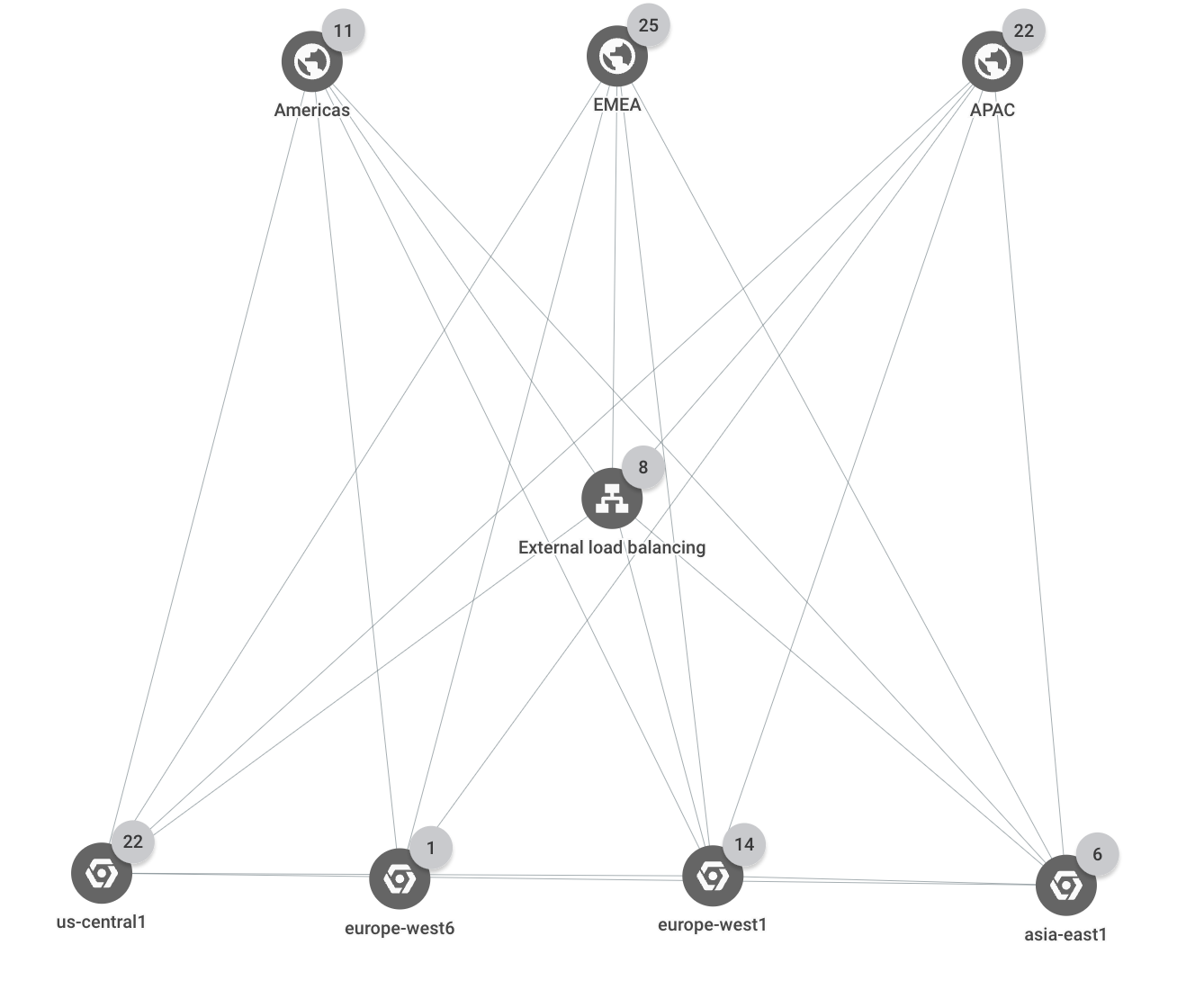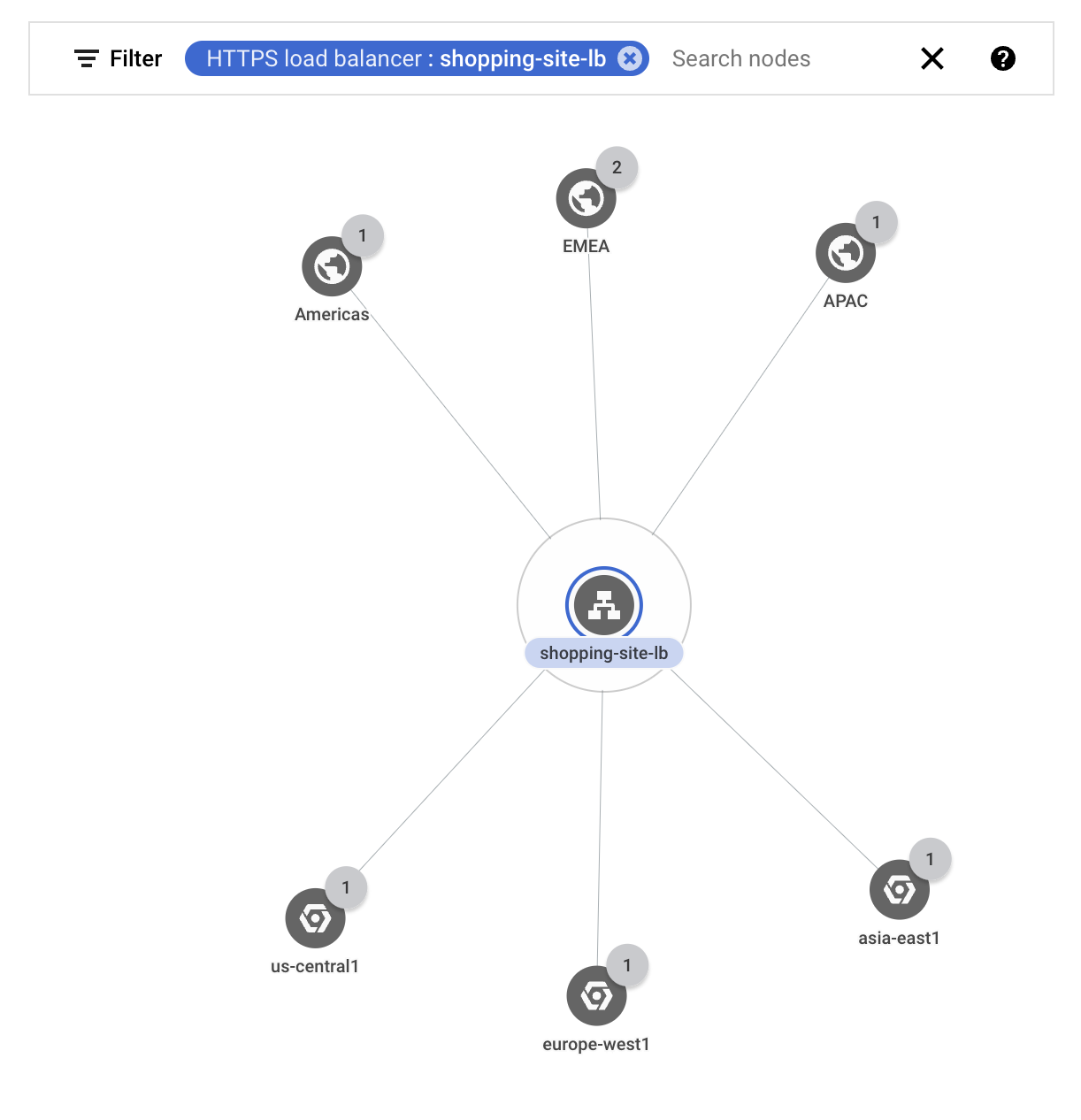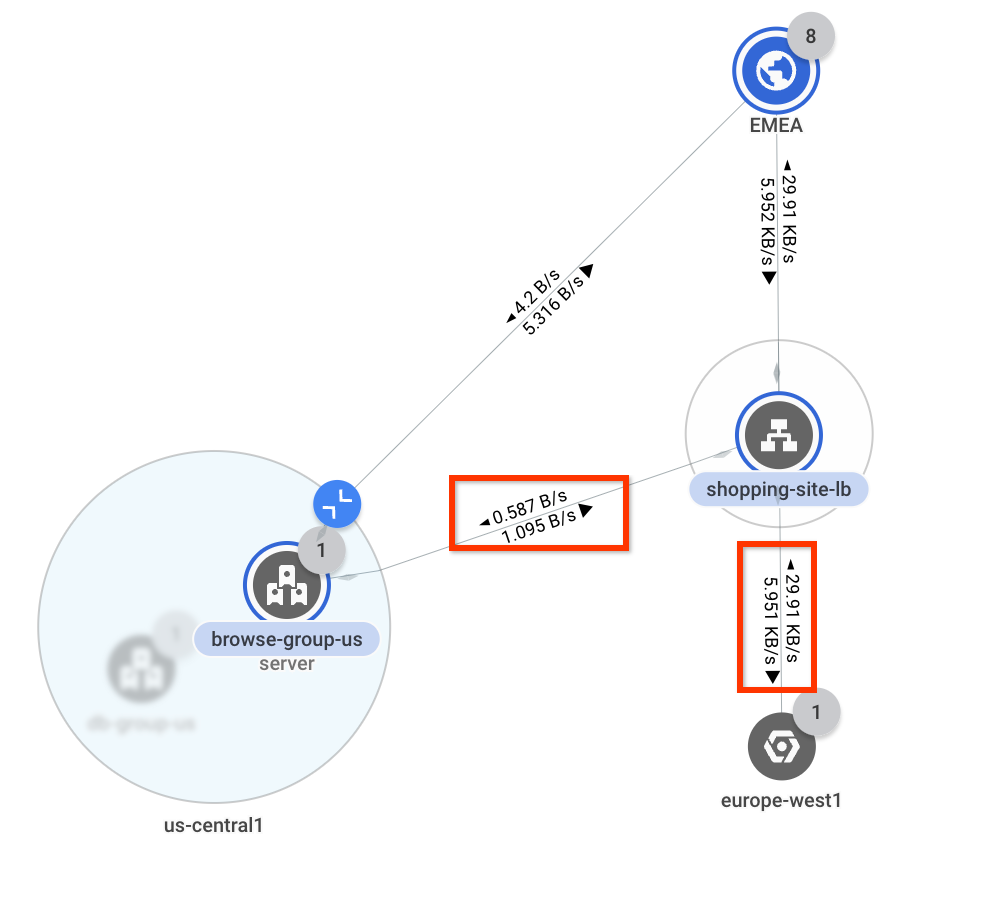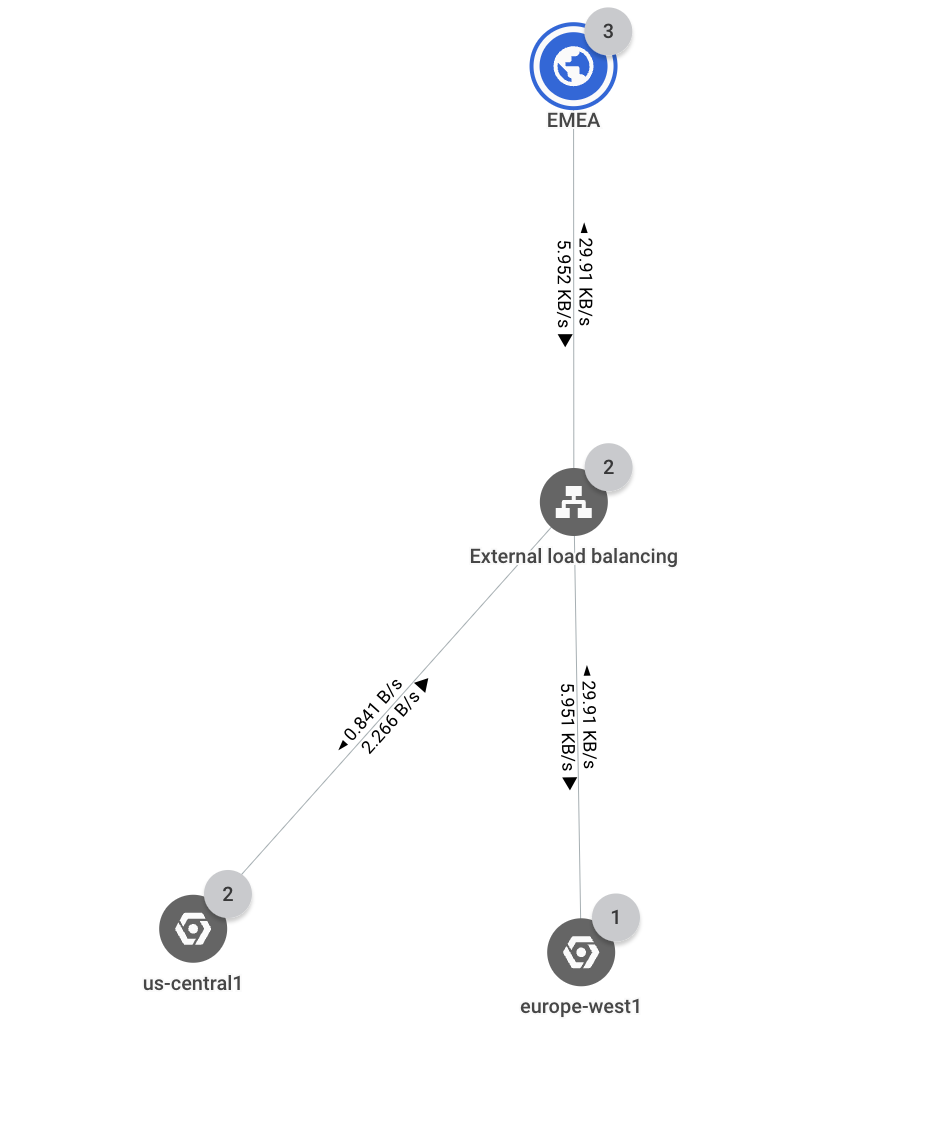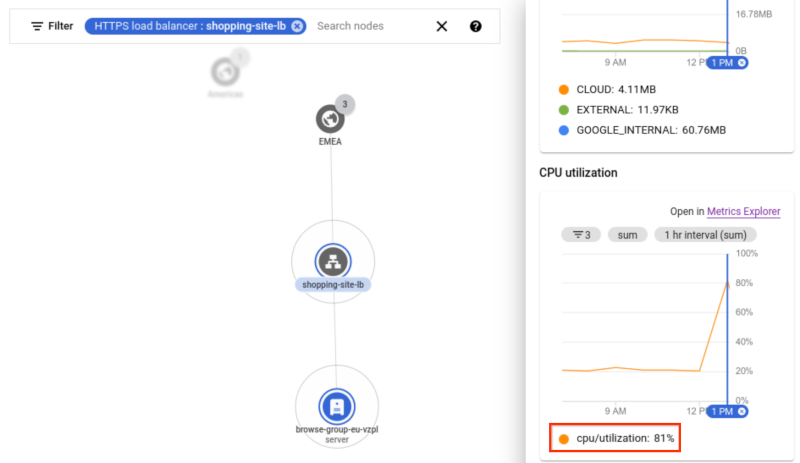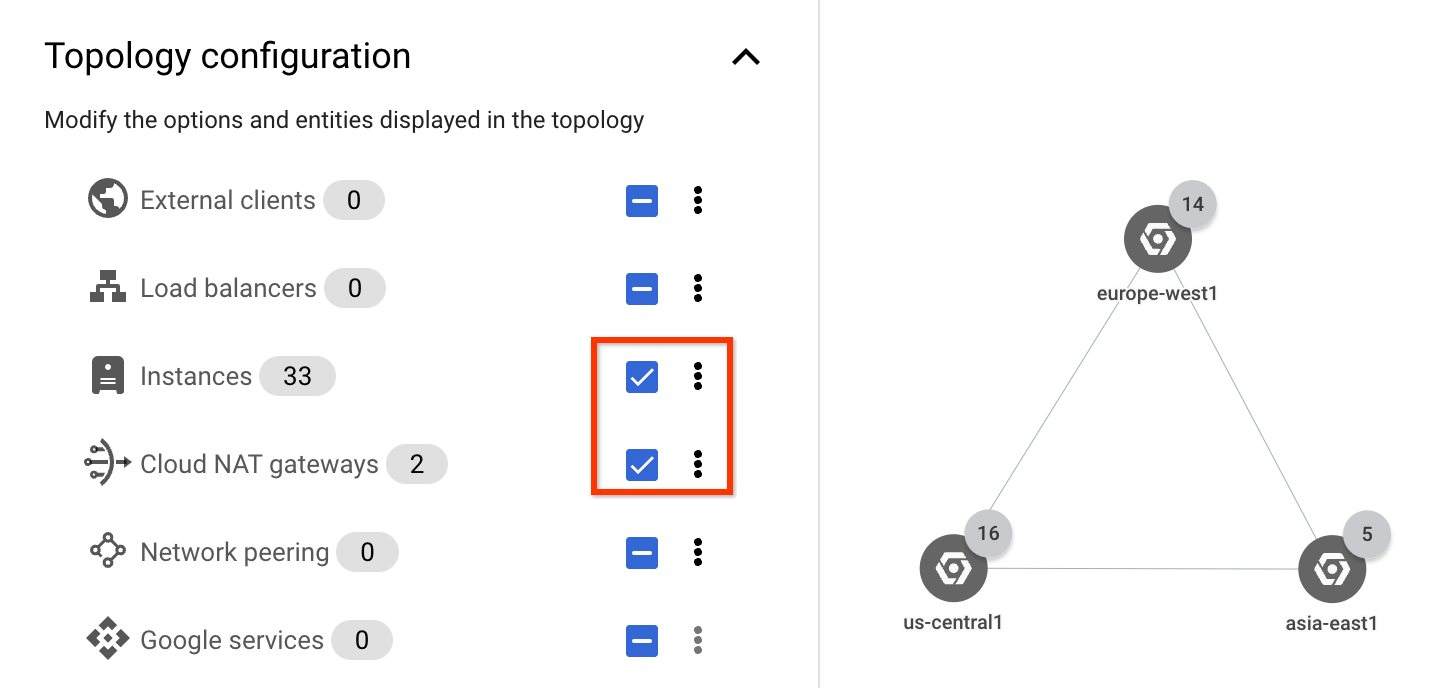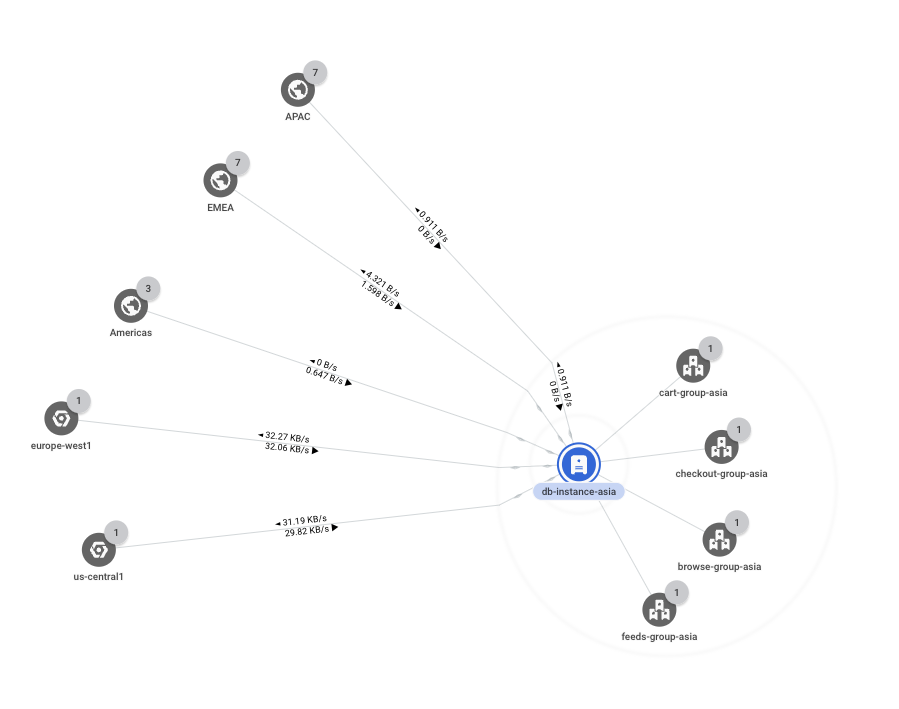Kasus penggunaan: Mengaudit performa jaringan
Misalkan Anda adalah administrator jaringan yang mendukung jaringan yang menyertakan beberapa aplikasi yang di-load balance. Anda telah diminta untuk mengaudit konfigurasi jaringan yang mendukung aplikasi tersebut untuk memastikan bahwa konfigurasi konsisten dengan status jaringan yang diharapkan. Dengan melakukan audit ini, Anda dapat memastikan bahwa pelanggan mendapatkan latensi serendah mungkin untuk aplikasi Anda.
Kasus penggunaan berikut menunjukkan cara Topologi Jaringan dapat membantu Anda memeriksa konfigurasi yang ada. Misalnya, Anda dapat memeriksa apakah semua permintaan klien ditayangkan oleh instance aplikasi dari region Google Cloudyang paling dekat dengan klien. Anda juga dapat memastikan bahwa traffic lintas-region rendah karena traffic tersebut berasal dari database yang mereplikasi data secara global.
Ringkasan topologi
Deployment ini mencakup tiga Google Cloud region (us-central1,
europe-west1, dan asia-east1). Semua permintaan klien eksternal ditayangkan oleh
satu Load Balancer Aplikasi eksternal yang memiliki beberapa backend di setiap dari tiga
region tersebut. Permintaan klien yang berasal dari salah satu dari tiga region bisnis (Amerika,
EMEA, dan APAC) ditayangkan oleh instance aplikasi di regionGoogle Cloud
terdekat.
Grafik berikut menunjukkan hierarki tingkat teratas untuk deployment.
Referensi dan jalur traffic
Dalam contoh ini, project berisi resource Google Cloud berikut:
1 load balancer HTTPS
4 layanan backend:
browse,shopping_cart,checkout, danfeeds12 grup instance (yang merupakan backend load balancer)
Ada satu grup instance untuk setiap layanan backend di setiap dari tiga region.
3 instance database, satu di setiap region
Anda memperkirakan bahwa traffic dari negara tertentu akan diarahkan ke lokasi berikut:
- Traffic dari negara di wilayah bisnis
Americasakan diarahkan ke backend di wilayahus-central1. Misalnya, traffic dari klien eksternal di Kanada akan melalui load balancer ke backendcheckoutdi regionus-central1. - Traffic dari negara di wilayah bisnis
EMEAakan diarahkan ke backend di wilayaheurope-west1. Misalnya, traffic dari klien eksternal di Polandia melalui load balancer ke backendcheckoutdi regioneurope-west1. - Traffic dari negara di wilayah bisnis
APACakan diarahkan ke backend di wilayahasia-east1. Misalnya, traffic dari klien eksternal di Jepang akan melalui load balancer ke backendcheckoutdi regionasia-east1. - Traffic ke instance database berasal dari backend di region yang sama. Misalnya, backend di
asia-east1hanya mengirim data ke instance database diasia-east1. - Traffic lintas region dibatasi untuk replikasi database. Misalnya, traffic
antara
us-central1daneurope-west1hanya berjalan di antara instance database di region tersebut.
Aliran traffic yang tidak terduga
Dalam skenario ini, Anda menemukan bahwa traffic dari region bisnis EMEA
sekarang mengarah ke dua region Google Cloud yang berbeda, yaitu us-central1 dan
europe-west1. Dengan menggunakan Topologi Jaringan, Anda menemukan bahwa salah satu
backend digunakan secara berlebihan.
Anda ingin memeriksa apakah traffic eksternal yang melewati load balancer pada akhirnya akan masuk ke region Google Cloud yang benar. Anda memfilter grafik untuk hanya menampilkan traffic untuk load balancer eksternal
shopping-site-lb.Setelah Anda menerapkan filter, Network Topology hanya akan menampilkan koneksi yang terkait dengan load balancer, seperti yang ditunjukkan dalam contoh berikut.
Anda menahan kursor di setiap wilayah bisnis untuk menandai komunikasi ke wilayah tersebut.
Saat mengarahkan kursor ke Amerika dan APAC, Anda akan melihat traffic yang menuju ke region Google Cloud terdekat:
us-central1danasia- east1. Namun, saat menahan kursor di EMEA, Anda akan melihat traffic yang mengarah keus-central1daneurope-west1. Idealnya, untuk mengurangi latensi, semua traffic dari EMEA harus diarahkan keeurope-west1.Selanjutnya, Anda mengklik EMEA untuk mempelajari throughput antara region tersebut dan regionGoogle Cloud . Topologi Jaringan menempatkan nilai bandwidth pada setiap koneksi. Anda melihat bahwa sekitar 0,58 byte per detik akan diarahkan ke
us-central1dan 29,9 kilobyte per detik akan diarahkan keeurope-west1. Anda tahu bahwa sebagian besar traffic diarahkan seperti yang Anda harapkan, tetapi beberapa traffic mengalir keus-central1.1Gambar ini hanya untuk referensi. Datanya tidak mencerminkan kasus penggunaan.
Untuk menyelidiki lebih lanjut, Anda perlu meluaskan
us-central1untuk melihat tujuan traffic. Karena hanya ada satu jaringan dengan satu subnet di region tersebut, Topologi Jaringan tidak menampilkan tingkat hierarki tersebut dan melewati grup instance.Anda melihat bahwa traffic mengarah ke grup instance yang terkait dengan layanan backend load balancer. Karena traffic yang masuk ke
europe-west1jumlahnya relatif sedikit, resource dieurope-west1mungkin digunakan secara berlebihan dan menyebabkan traffic meluap keus-central1.1Gambar ini hanya untuk referensi. Datanya tidak mencerminkan kasus penggunaan.
Untuk mengonfirmasi kesimpulan Anda, luaskan region
europe-west1hingga Anda mencapai instance yang terkait dengan layanan backend load balancer yang sama. Network Topology menampilkan diagram deret waktu di panel detail untuk instance.Pada diagram, Anda melihat bahwa rasio penggunaan CPU adalah 81% untuk instance. Batas untuk contoh ini adalah 80%, yang menunjukkan bahwa instance tersebut kelebihan permintaan. Anda dapat mengatasi masalah ini dengan menskalakan grup instance sehingga traffic kembali ke alur yang ideal.
1Gambar ini hanya untuk referensi. Datanya tidak mencerminkan kasus penggunaan.
Traffic antar-region
Di bagian berikut, Anda akan memeriksa apakah traffic internal antar-region hanya dibatasi untuk traffic instance database.
Untuk berfokus pada traffic internal, dalam daftar Topology configuration, Anda hanya memilih kotak centang Instances dan Cloud NAT gateways. Karena Anda hanya melihat traffic dalam aplikasi, Anda tidak perlu melihat klien eksternal dan traffic load balancer eksternal.
Anda meluaskan region
asia-east1, dan Anda melihat lima grup instance. Data tersebut tidak digabungkan menurut jaringan, subnet, atau zona karena semuanya berada di jaringan, subnet, dan sebagainya yang sama.Anda melihat bahwa hanya satu grup instance (
db-group-asia) yang berisi jalur untuk traffic antar-region. Semua grup instance lainnya berkomunikasi dalam region.Anda terus memperluas grup
db-group-asiahingga mencapai entity dasar. Dalam skenario ini, entitas dasar adalah instance virtual machine (VM) (db-instance-asia) yang bertindak sebagai server database. Instance tersebut berkomunikasi dengan region lain untuk mereplikasi data, yang merupakan hal yang Anda harapkan, sehingga tidak diperlukan penyelidikan lebih lanjut. ̦1Gambar ini hanya untuk referensi. Datanya tidak mencerminkan kasus penggunaan.
Langkah berikutnya
- Memantau konfigurasi jaringan dengan Topologi Jaringan
- Kasus penggunaan: Memecahkan masalah konektivitas jaringan
- Memecahkan Masalah Topologi Jaringan


